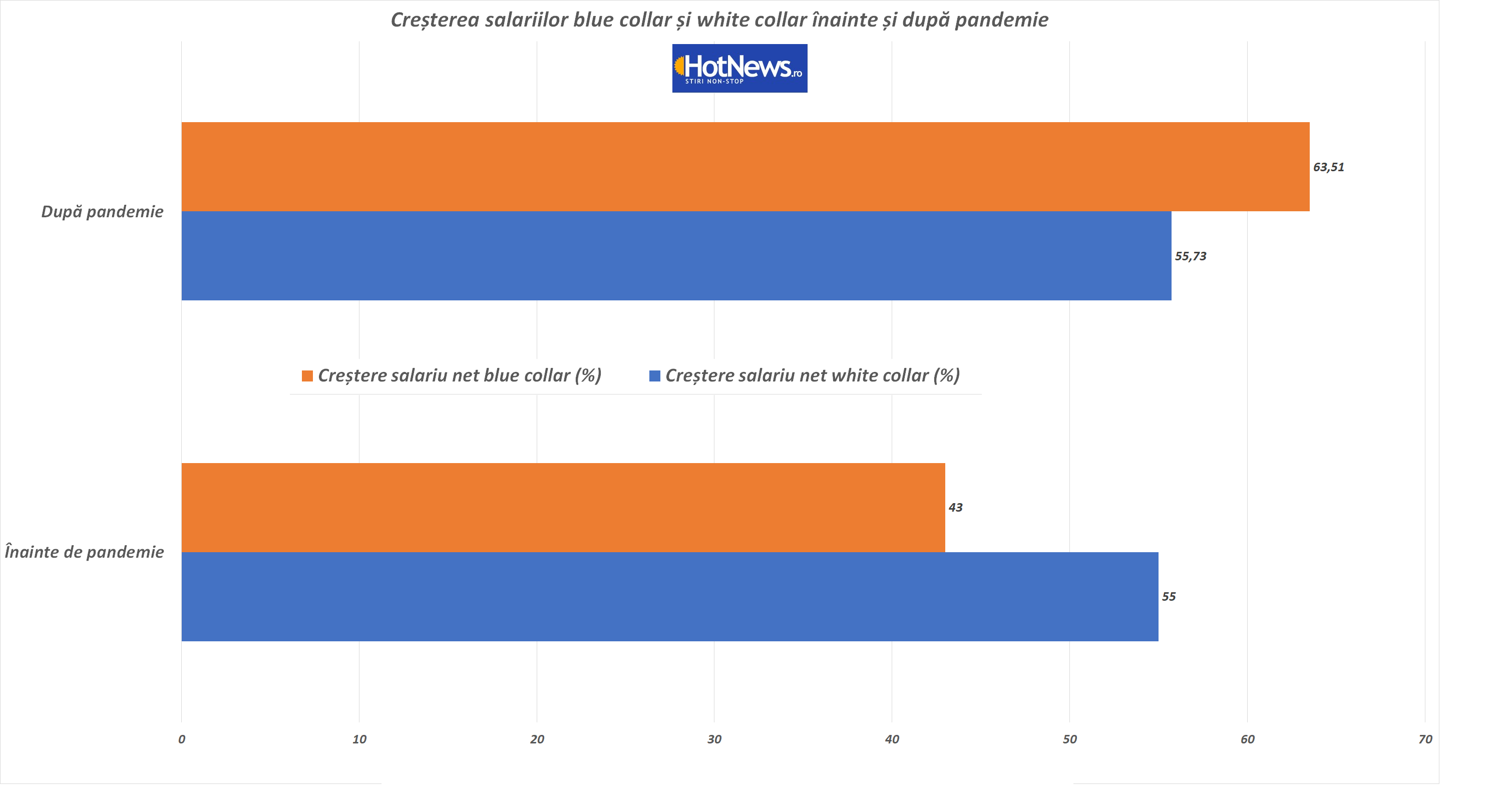
This happens not only in Romania, but we checked whether this trend is confirmed in Romania as well. Before the pandemic, so-called “white-collar” wages grew faster than “blue-collar workers,” but the pandemic has reversed that trend.
Civil servants include workers in construction, transport, production, public catering, leisure, hospitality, cosmetic services, health care, etc.
“White-collar” jobs include office, administrative or management jobs. Some examples are IT&C, accounting, marketing and consulting. The term “white collar” refers to the white shirts that many of these professionals wear to the office.
We looked at the data provided by Statistica, and yes, before the pandemic, blue-collar wages increased by 43% and white-collar wages by 55%.
But in the period 2019-2023, salary increases in Romania amounted to 63% for workers and slightly more than 50% for white-collar workers.

For younger generations, working in a corporation seemed like a dream job. Not anymore. The pandemic has changed this state of affairs. Banking work, for which mountains of money were offered before the 2009-2012 crisis, is now paid very modestly, and people go out on their heads. In addition, new technologies are replacing many jobs that people did 10 years ago.
Even Meta CEO Mark Zuckerberg told employees that many jobs would be replaced by new technologies that would allow the company to be more efficient. Similarly, IBM CEO Arvind Krishna said the firm may pause hiring to see what back-office work can be done with AI.
White-collar jobs usually require a college degree. These professionals may require at least a high school diploma or bachelor’s degree, and often have greater earning potential with additional education.
Blue-collar jobs provide on-the-job training through apprenticeships or vocational schools. Some higher-paying, more specialized jobs also require certain certifications or technical skills.
Explication
After the Corona pandemic and the recovery of the economy, the number of vacancies in construction and other fields of work has increased. In addition, retailers such as MegaImage, Kaufland or Lidl had to raise wages in order to attract the new workers they really needed.
The same is the case with specialized workers: plumbers, electricians, tilers, carpenters, who are hard to find and sometimes demand astronomical prices. Unfortunately, the education system is not adapted to provide a serious job offer in these segments, and the demographic factor is creating more and more pressure. The inevitable retirement (within a few years) of the “baby” generation will create a gap between the demand for labor and the available supply of labor.
If firms perceived the lack of labor supply in the market as temporary, they would keep wages low by offering hiring bonuses. But the fact that wages are steadily rising suggests that business owners are aware that labor shortages will continue for some time.
According to statistics, the highest job vacancies this summer were in banking, energy, sanitation and waste management.
Moreover, more than a quarter of the total number of vacant jobs was concentrated in industry.
The vacancy rate is the ratio of the number of vacant jobs to the total number
jobs (occupied and vacant, with the exception of those blocked or designated only for promotion within the company, expressed as a percentage).
Lack of skills and jobs in the places where people live make employment difficult.
The growth of employment in the public sector is 3 times higher than the growth of the entire economy
The sectors of non-competitive activities (public administration and defense, education, health care and social assistance) represent a total of 1,238,000 employed people in 2020, or in figures relative to the total number of employed population 14.1%, Katelin explained to HotNews Ghinăraru, labor market expert.
Public administration, national defense and public order, including the judiciary, together represent 453,000 people in 2020 and will reach 495,000 people in 2030, mainly due to increased staff in the administration. Growth from 2030 to 2020 will be 9.2%.
This growth, which is below the global level of the uncompetitive sector, is essentially a mirror of adverse demographic developments. In fact, this may also be the last quantitative growth of the sector, which we believe will enter a decline after 2035 and especially after 2040, which will intensify as Romania’s school-age population begins to decline sharply, says Gineraru.
In 2030, the distribution and transportation sector will be the most important generator of job demand in the Romanian economy! This evolution is worrying for Romania, says Gineraru, these two sectors with low productivity, which create almost no added value, whose output cannot be determined in physical terms, will together represent in absolute terms 2,365,000 workers or 24.9% of the total employed population, the study also shows.
The primary sector, which includes: agriculture and fishing, the extractive sector, including quarries, and the production of electricity, gas, water and other utilities, will continue to decline in the decade starting next year. In general, in the main branches of this sector (agriculture, mining, oil and gas production, electricity and heat production) in 2030, the number of employed people will decrease in absolute terms from 2.21 million to 1.7 million people.
Source: Hot News
Lori Barajas is an accomplished journalist, known for her insightful and thought-provoking writing on economy. She currently works as a writer at 247 news reel. With a passion for understanding the economy, Lori’s writing delves deep into the financial issues that matter most, providing readers with a unique perspective on current events.